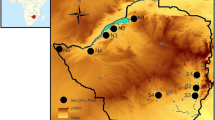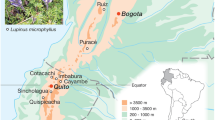Abstract
The tropical alpine flora in the northern Andes has caught the attention of evolutionary biologists and conservationists because of the extent of its diversity and its vulnerability. Although population genetics studies are essential to understand how diversity arises and how it can be maintained, plant populations occurring above 4100 m a.s.l. in the so-called super-páramo have rarely been studied at the molecular level. Here, we use 11 microsatellite DNA markers to examine genetic structure in populations of Lupinus alopecuroides, a long-lived semelparous giant rosette known from only 10 geographically isolated populations. Each population is located on a different mountain top, of which three are in Colombia and seven in Ecuador. We analysed 220 individuals from all the ten known populations. We find low genetic variation in all but one of the populations. Four populations are completely monomorphic, and another five show only one polymorphic locus each. On the other hand, we find extremely high genetic differentiation between populations. We discuss the mechanisms that might cause this pattern, and we suggest that it is related to founder effects, lack of gene flow, and autogamy. The genetic relationships among the populations, and the lack of correlation between the genetic and geographic distances also point to the importance of founder effects and colonization history in driving differentiation among the populations.



Similar content being viewed by others
References
Allendorf FW, Luikart G (2006) Conservation and the genetics of populations. Blackwell, London
Arroyo MTK, Armesto JJ, Primack RB (1985) Community studies in pollination ecology in the high temperate Andes of central Chile II. Effect of temperature on visitation rates and pollination possibilities. Plant Syst Evol 149:187–203
Australian Government. Department of Health and Ageing, Office of the Gene Technology Regulator (2013) The biology of Lupinus L. (lupin or lupine). http://ogtr.gov.au/internet/ogtr/publishing.nsf/Content/biologylupin2013-toc/$FILE/biologylupin20132.pdf. Accessed 5 March 2016
Baker HG (1967) Support for Baker’s law—as a rule. Evolution 21:853–856
Balslev H, Luteyn JL (1992) Páramo: an Andean ecosystem under human influence. Academic Press, London
Barbara T, Palma-Silva C, Paggi GM, Bered F, Fay MF, Lexer C (2007) Cross-species transfer of nuclear microsatellite markers: potential and limitations. Mol Ecol 16:3759–3767
Bech N, Boissier J, Drovetski S, Novoa C (2009) Population genetic structure of rock ptarmigan in the ‘sky islands’ of French Pyrenees: implications for conservation. Anim Conserv 12:138–146
Beheregaray LB, Ciofi C, Geist D, Gibbs JP, Caccone A, Powell JR (2003) Genes record a prehistoric volcano eruption in the Galápagos. Science 302:75
Berry PE, Calvo RN (1989) Wind pollination, self-incompatibility, and altitudinal shifts in pollination systems in the high Andean genus Espeletia (Asteraceae). Am J Bot 76:1602–1614
Bezault E, Rognon X, Gharbi K, Baroiller JF, Chevassus B (2012) Microsatellites cross-species amplification across some African cichlids. Int J Evolut Biol. doi:10.1155/2012/870935
Carlquist S (1974) Island biology. Columbia University Press, New York
Carson HL, Templeton AR (1984) Genetic revolutions in relation to speciation phenomena: the founding of new populations. Annu Rev Ecol Syst 15:97–131
Carson HL, Lockwood JP, Craddock EM (1990) Extinction and recolonization of local populations on a growing shield volcano. Proc Natl Acad Sci USA 87:7055–7057
Clegg SM, Degnan SM, Kikkawa J, Moritz C, Estoup A, Owens IP (2002) Genetic consequences of sequential founder events by an island-colonizing bird. Proc Natl Acad Sci USA 99:8127–8132
Cuatrecasas J (1968) Páramo vegetation and its life-forms. In: Troll C (ed) Geoecology of mountainous regions of the tropical America. Colloquium geographicum 9. Geographisches Institut, Bonn, pp 163–186
de Jong TJ, Waser NM, Klinkhamer PGL (1993) Geitonogamy: the neglected side of selfing. Trends Ecol Evol 8:321–325
Dillon ME, Frazier MR, Dudley R (2006) Into thin air: physiology and evolution of alpine insects. Integr Comp Biol 46:49–61
Drummond CS, Hamilton MB (2005) Isolation and characterization of nuclear microsatelliteloci in Lupinus group Microcarpi (Leguminosae). Mol Ecol Notes 5:510–513
Drummond CS, Eastwood RJ, Miotto ST, Hughes CE (2012) Multiple continental radiations and correlates of diversification in Lupinus (Leguminosae): testing for key innovation with incomplete taxon sampling. Syst Biol 61:443–460
East EM (1940) The distribution of self-sterility in the flowering plants. Proc Am Philos Soc 82:449–518
Ellstrand NC, Elam DR (1993) Population genetic consequences of small population size: implications for plant conservation. Annu Rev Ecol Syst 24:217–242
Excoffier L, Lischer HEL (2010) Arlequin suite ver 3.5: a new series of programs to perform population genetics analyses under Linux and Windows. Mol Ecol Resour 10:564–567
Fagan WF, Lewis M, Neubert MG, Aumann C, Apple JL, Bishop JG (2005) When can herbivores slow or reverse the spread of an invading plant? A test case from Mount St. Helens. Am Nat 166:669–685
Frankham R, Ballou JD, Briscoe DA (2002) Introduction to conservation genetics. Cambridge University Press, Cambridge
Goldstein DB, Ruiz Linares A, Cavalli-Sforza LL, Feldman MW (1995) Genetic absolute dating based on microsatellites and the origin of modern humans. Proc Natl Acad Sci USA 92:6723–6727
Goudet J (2001) FSTAT, a program to estimate and test gene diversities and fixation indices (version 2.9.3)
Graham A (2009) The Andes: a geological overview from a biological perspective. Ann Missouri Bot Gard 96:371–385
Hamrick JL, Godt MJW (1996) Effects of life history traits on genetic diversity in plant species. Philos Trans R Soc B 351:1291–1298
Hedrick PW (1996) Bottleneck(s) or metapopulation in cheetahs. Conserv Biol 10:897–899
Hewitt GM (2000) The genetic legacy of the Quaternary ice ages. Nature 405:907–913
Hoeck PE, Bollmer JL, Parker PG, Keller LF (2010) Differentiation with drift: a spatio-temporal genetic analysis of Galápagos mockingbird populations (Mimus spp.). Philos Trans R Soc B 365:1127–1138
Hooghiemstra H, Wijninga VM, Cleef AM (2006) The paleobotanical record of Colombia: implications for biogeography and biodiversity. Ann Missouri Bot Gard 93:297–324
Hughes C, Eastwood R (2006) Island radiation on a continental scale: exceptional rates of plant diversification after uplift of the Andes. Proc Natl Acad Sci USA 103:10334–10339
Jombart T, Ahmed I (2011) adegenet 1.3-1: new tools for the analysis of genome-wide SNP data. Bioinformatics 27:3070–3071
Karoly K (1992) Pollinator limitation in the facultatively autogamousannual, Lupinus nanus (Leguminosae). Am J Bot 79:49–56
Kittelson PM, Maron JL (2000) Outcrossing rate and inbreeding depression in the perennial yellow bush lupine, Lupinus arboreus (Fabaceae). Am J Bot 87:652–660
Kroonenberg SB, Bakker JG, van der Wiel AM (1990) Late Cenozoic uplift and paleogeography of the Colombian Andes: constraints on the development of high-Andean biota. Geol Mijnbouw 6:279–290
Lesica P, Allendorf FW (1995) When peripheral populations are valuable for conservation. Conserv Biol 9:753–760
Madriñán S, Cortés AJ, Richardson JE (2013) Páramo is the world’s fastest evolving and coolest biodiversity hotspot. Front Genet 4:192
Manel S, Holderegger R (2013) Ten years of landscape genetics. Trends Ecol Evol 28:614–621
Maron JL, Kauffman MJ (2006) Habitat-specific impacts of multiple consumers on plant population dynamics. Ecology 87:113–124
Mayr E (1954) Change of genetic environment and evolution. In: Huxley J, Hardy AC, Ford EB (eds) Evolution as a process. Allen and Unwin, London, pp 157–180
Milla R, Iriondo AEM (2011) Congruence between geographic range distribution and local competitive ability of two Lupinus species. Am J Bot 98:1456–1464
Miller GA (1986) Pubescence, floral temperature and fecundity in species of Puya (Bromeliaceae) in the Ecuadorian Andes. Oecologia 70:1432–1939
Molecular Ecology Resources Primer Development Consortium, Abreu AG, Albaina A, Alpermann TJ, Apkenas VE et al (2012) Permanent genetic resources added to molecular ecology resources database 1 October 2011–30 November 2011. Mol Ecol Resour 12:374–376
Monasterio M (1986) Adaptive strategies of Espeletia in the Andean desert páramo. In: Vuilleumier F, Monasterio M (eds) High altitude tropical biogeography. Oxford University Press, New York, pp 49–80
Morueta-Holme N, Engemann K, Sandoval-Acuña P, Jonas JD, Segnitz RM, Svenning JC (2015) Strong upslope shifts in Chimborazo’s vegetation over two centuries since Humboldt. Proc Natl Acad Sci USA 112:12741–12745
Nei M (1987) Molecular evolutionary genetics. Columbia University Press, New York
Oleas NH, Meerow AW, Francisco-Ortega J (2012) Population dynamics of the endangered plant, Phaedranassa tunguraguae, from the Tropical Andean Hotspot. J Hered 103:557–569
Pazy B (1984) Insect induced self-pollination. Plant Syst Evol 144:315–320
Prugnolle F, Manica A, Balloux F (2005) Geography predicts neutral genetic diversity of human populations. Curr Biol 15:R159–R160
Rangel O (2006) The biodiversity of the Colombian páramo and its relation to antropoghenic impact. In: Spehn EM et al (eds) Land use change and mountain biodiversity. CRC Press, Boca Raton, pp 108–109
Richards AJ (1986) Plant breeding systems. George Allen & Unwin, London
Rossetto M (2001) Sourcing of SSR markers from related plant species. In: Henry RJ (ed) Plant genotyping: the DNA fingerprinting of plants. CAB International, Oxford, pp 211–224
Rundel PW, Smith AP, Meinzer FC (1994) Tropical alpine environments: plant form and function. Cambridge University Press, Cambridge
Selkoe KA, Toonen RJ (2006) Microsatellites for ecologists: a practical guide to using and evaluating microsatellite markers. Ecol Lett 9:615–629
Sgorbati S, Labra M, Grugni E et al (2004) A survey of genetic diversity and reproductive biology of Puya raimondii (Bromeliaceae), the endangered queen of the Andes. Plant Biol 6:222–230
Sklenar P, Ramsay PM (2001) Diversity of zonal páramo plant communities in Ecuador. Divers Distrib 7:113–124
Sklenář P, Duškova E, Balslev H (2011) Tropical and temperate: evolutionary history of páramo flora. Bot Rev 2:71–108
Slatkin M (1987) Gene flow and the geographic structure of natural populations. Science 236:787–792
Slatkin M (1995) A measure of population subdivision based on microsatellite allele frequencies. Genetics 139:457–462
Smith JMB, Cleef AM (1988) Composition and origins of the world’s tropicalpine floras. J Biogeogr 15:631–645
Spurgin LG, Illera JC, Jorgensen TH, Dawson DA, Richardson DS (2014) Genetic and phenotypic divergence in an island bird: isolation by distance, by colonization or by adaptation? Mol Ecol 5:1028–1039
Takezaki N, Nei M, Tamura K (2014) POPTREEW : web version of POPTREE for constructing population trees from allele frequency data and computing other population statistics. Mol Biol Evol 31:1622–1624
van der Hammen T, Cleef AM (1986) Development of the high Andean páramo flora and vegetation. In: Vuilleumier F, Monasterio M (eds) High altitude tropical biogeography. Oxford University Press, Oxford, pp 153–201
van der Hammen T, Werner JH, van Dommelen H (1973) Palynological record of the upheaval of the Northern Andes: a study of the Pliocene and Lower Quaternary of the Colombian Eastern Cordillera and the early evolution of its high-Andean biota. Palaeogeogr Palaeocl 16:1–24
Vásquez DLA, Balslev H, Sklenář P (2015) Human impact on tropical-alpine plant diversity in the northern Andes. Biodivers Conserv 24:2673–2683
Weir BS, Cockerham CC (1984) Estimating F-statistics for the analysis of population structure. Evolution 38:1358–1370
Young TP, Augspurger CK (1991) Ecology and evolution of long-lived semelparous plants. Trends Ecol Evol 6:285
Acknowledgments
Thanks to Eva Dušková and Lenka Flašková for laboratory assistance, and to Jan Brotánek and Vojtěch Zeisek for help with fieldwork. We also thank Filip Kolář for helpful discussions and the Fond Mobility of Charles University in Prague for financial support.
Author information
Authors and Affiliations
Corresponding author
Ethics declarations
Conflict of interest
The authors declare that they have no conflict of interest.
Electronic supplementary material
Below is the link to the electronic supplementary material.
35_2016_165_MOESM1_ESM.docx
Additional supporting information in the online version of this article (see “Supplementary Material”) contains the following: ESM_1 – Allele frequencies
Rights and permissions
About this article
Cite this article
Vásquez, D.L.A., Balslev, H., Hansen, M.M. et al. Low genetic variation and high differentiation across sky island populations of Lupinus alopecuroides (Fabaceae) in the northern Andes. Alp Botany 126, 135–142 (2016). https://doi.org/10.1007/s00035-016-0165-7
Received:
Accepted:
Published:
Issue Date:
DOI: https://doi.org/10.1007/s00035-016-0165-7




